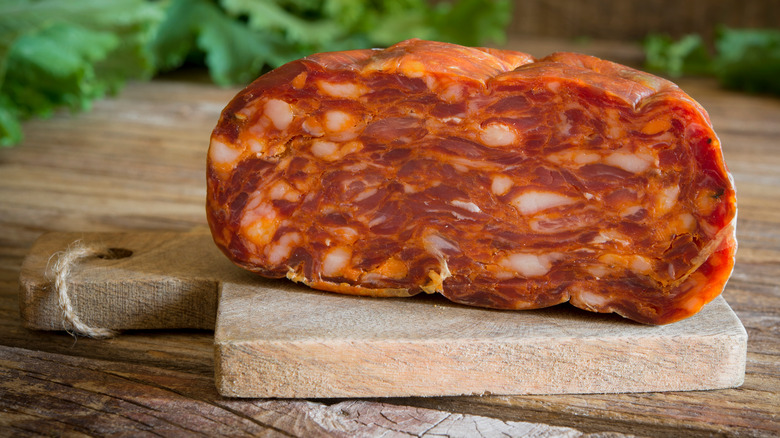How Early Italian Immigrants Used Cheese To Sneak Sausage Into The US
The early 20th century saw more than four million Italians immigrate to the United States, according to PBS. This wave of migrants was escaping the poverty endemic in the southern part of the country. Of course, they were eager to bring the flavors of home to their new country, except at the time, the United States had a strict ban on imports of pork meat. However, imported cheese was not restricted. Seeing this loophole, the Italians created a sort of Trojan horse to get a beloved form of cured sausage — soppressata — into the United States.
But first, what is soppressata? According to Il Porcellino Salumi, it's a type of salami made from lean cuts of pork, which can include the shoulder, loin, and ham scraps mixed with lard to give it a marbled look and soft texture. The spices added to the pork vary regionally, but they are often some variation of salt, pepper, cinnamon, chili pepper, and rosemary. Once the pork is added to the casing and begins the drying process, the soppressata is pressed, which gives it a flatter shape than its cured cousin.
La Cucina Italiana explains that while soppressata is found all over the world, it originated in Southern Italy. However, only the Calabrian soppressata has designation-of-origin (DOP) status. Northern Italian varieties called sopressa use fattier parts of the pig.
How the Italians smuggled soppressata in cheese
Caciocavallo cheese, a southern Italian staple, is made from either sheep or cow milk, explains Cheese.com. Its trademark pear shape comes from the way it is tied with a rope and hung to dry and age. Di Pasquo Dairy notes that the cheese is aged inside tuff caves, which produces its earthy, salty flavor.
More importantly to the Italian migrants, caciocavallo is a pasta filata, or a spun paste cheese. Culture explains that during the cheesemaking process, the cheese curds are spun dry, and then stretched and kneaded until they are soft and stringy. A pasta filata cheese, like mozzarella, is eaten right away. A caciocavallo, however, is formed into balls and hung to dry.
The Italians figured out they could hide their precious soppressata in the caciocavallo cheese, which they called caciocavallo dell'emigrante — translated into "Caciocavallo of the Migrant" (via Atlas Obscura). Culinary Backstreets states that the texture of the cheese — that stringy pasta filata — allowed it to be wrapped around the cured meat, making it easy to smuggle into the U.S. Of course, this was a relatively slow process. First, the soppressata needed to be cured for a year. Afterward, the cheese took a year to dry.
Luckily, the ban on soppressata was lifted in 2013 (via NPR). Now, Americans can enjoy the delicacy in their Italian subs or as a spicy addition to pasta.

